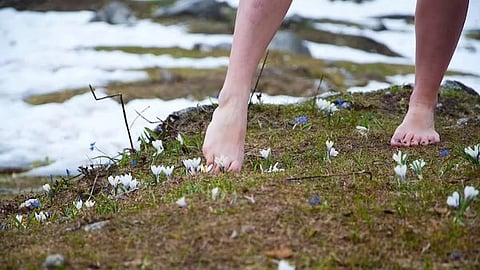Winter Alert: Protect Your Feet During Cold Weather
For many people, the start of winter means pleasant evenings by the fireplace, holiday celebrations, and making plans for skiing and other snow sports. But it isn’t all fun and games. During the cold weather months, orthopedic specialists at Hospital for Special Surgery (HSS) often see an uptick in injuries and foot problems that could be avoided with good practices. They urge everyone to prepare for cold weather challenges.
The first step is to make sure that winter shoes and boots stored away for almost a year still fit well, says Dr. Mark Drakos, an orthopedic foot and ankle surgeon at HSS Long Island and the main hospital in Manhattan. “Our feet change as we get older, and footwear that fit us last year may now be too tight,” he explains. “Squeezing your feet into shoes that are too snug can lead to foot pain, blisters, bruises, and other problems.”
When shopping for new shoes or boots, Dr. Drakos recommends going to the store in the late afternoon or evening because our feet tend to get bigger as the day goes on. He says it’s a good idea to bring the socks you plan to wear in the cold weather, as they may be thicker and need more room in the shoe.
Good traction is as important as fit when streets are covered with snow and ice. “It may seem like common sense, but the first winter storm of the season often catches people off guard, and we tend to see more injuries,” says Dr. Andrew Elliott, an orthopedic foot and ankle surgeon at HSS locations in Manhattan and Paramus, New Jersey. He recommends keeping a spare pair of winter shoes at work in the event of unexpected snow. Various types of anti-slip shoe covers, which are easy to find online, can also provide traction on slick surfaces.
Winterize Your Feet
For many of us, moisturizing our face and hands during the winter is a must, but we may not give much thought to dry skin on our feet. If you are prone to dry, cracked heels and other problems that are more common in winter, experts recommend moisturizing your feet daily.
It is also important to keep your feet clean and dry to ward off fungus and infections such as athlete’s foot. Acrylic-blend socks that wick away moisture can help. Experts recommend changing socks after exercising, engaging in winter activities, or at the end of the day, when appropriate. If shoes and socks become wet, be sure to dry them out overnight, Dr. Elliott says.
Very low temperatures can be hard on our feet. Exposure to cold air causes the body to slow blood circulation to the extremities to preserve the body’s core temperature. If you must be out in the cold, water-resistant, insulated footwear and warm socks are essential. The potential for frostbite must never be taken lightly, Dr. Elliott says. Anyone who starts to experience numbness and pain is advised to go to a warmer environment as soon as possible. People with diabetes are at particular risk, as nerve damage known as neuropathy may prevent them from feeling the cold, he notes.
Preparing for Winter Sports
Whether returning to a winter sport such as skiing or trying a new one, strength training and conditioning in advance are important to get your body ready, says Dr. James Wyss, a physiatrist at HSS Long Island who specializes in treating patients with sports injuries and other painful conditions. “Everyone should also take the time to warm up before an athletic activity,” he says. “This is essential to prevent injury."
An effective 10-minute warm-up targets the muscles that will be used in the planned activity, Dr. Wyss explains. For example, if someone is going hiking or snowshoeing, some brisk walking on a level surface or climbing a couple of flights of stairs beforehand would be good.
Many people are devoted to outdoor running year-round, and wearing a shoe with good traction is important, says Dr. Tony Wanich, an orthopedic surgeon at the HSS Sports Medicine Institute in Manhattan. “Much like the way we change our tires to deal with winter weather, we advise runners to wear the appropriate shoes for the season,” he says. Sometimes that means going to a specialized shoe store, where employees can help you choose the right shoe and ensure a good fit.
Dr. Wanich also recommends wearing insulated socks in very cold weather. He notes that running enthusiasts are often ‘‘in the zone’’ – so caught up in the sport, they may not realize they are developing mild frostbite. In addition to good cold weather gear, awareness of dropping temperatures is critical to stay safe.
Anyone who starts to experience pain during activity should stop and take a break, the doctors say. For a foot problem that isn’t improving, it’s best to see a doctor sooner rather than later. If you have vowed to get more exercise in the New Year, taking care of your feet now will enable you to keep that resolution later. (NJ/Newswise)


